| Colpocoryphe | |
|---|---|
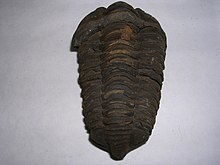 | |
| Colpocoryphe grandis | |
| Scientific classification | |
| Kingdom: | |
| Phylum: | |
| Class: | |
| Order: | |
| Suborder: | |
| Family: | |
| Genus: | †Colpocoryphe |
| species | |
† Colpocoryphe grandis | |
Colpocoryphe is a genus of trilobites in the family Calymenidae. [1]
| Colpocoryphe | |
|---|---|
 | |
| Colpocoryphe grandis | |
| Scientific classification | |
| Kingdom: | |
| Phylum: | |
| Class: | |
| Order: | |
| Suborder: | |
| Family: | |
| Genus: | †Colpocoryphe |
| species | |
† Colpocoryphe grandis | |
Colpocoryphe is a genus of trilobites in the family Calymenidae. [1]

In anatomy, the atlas (C1) is the most superior (first) cervical vertebra of the spine and is located in the neck. It is named for Atlas of Greek mythology because, just as Atlas supported the globe, it supports the entire head.

The radius or bot bone is one of the two large bones of the forearm, the other being the ulna. It extends from the lateral side of the elbow to the thumb side of the wrist and runs parallel to the ulna. The ulna is usually slightly longer than the radius, but the radius is thicker. Therefore the radius is considered to be the larger of the two. It is a long bone, prism-shaped and slightly curved longitudinally.

Phacops is a genus of trilobites in the order Phacopida, family Phacopidae, that lived in Europe, northwestern Africa, North and South America and China from the Late Ordovician until the very end of the Devonian, with a broader time range described from the Late Ordovician. It was a rounded animal, with a globose head and large eyes, and probably fed on detritus. Phacops is often found rolled up ("volvation"), a biological defense mechanism that is widespread among smaller trilobites but further perfected in this genus.

Huntoniatonia is genus of trilobites, an extinct group of marine arthropods of average to large size.

Triarthrus is a genus of Upper Ordovician ptychopariid trilobite found in New York, Ohio, Kentucky, and Indiana, eastern and northern Canada, China and Scandinavia. It is the last of the Olenid trilobites, a group which flourished in the Cambrian period. The specimens of T. eatoni that are found in the Beecher's Trilobite Bed, Rome, New York area are exquisitely preserved showing soft body parts in iron pyrite. Pyrite preservation has given scientists a rare opportunity to examine the gills, walking legs, antennae and digestive systems of trilobites, which are rarely preserved. Triarthrus is therefore commonly used in science texts to illustrate trilobite anatomy and physiology.

Asaphus is a genus of trilobites, that is known from the Lower and Middle Ordovician of northwestern Europe.

Dikelocephalus is a genus of very large trilobites of up to 50 cm (20 in) long, that lived during the last 3 million years of the Cambrian (Sunwaptan). Their fossils are commonly found as disarticulated sclerites, in the upper Mississippi Valley and in Canada (Alberta). The exoskeleton is rounded anteriorly, with the thorax and sides of the tailshield slightly tapering to about ⅔× of the width across the base of the spines at the back of the headshield. At the side corners of the pygidium there may be triangular or hooked spines, pointing backwards, while between the spines the posterior margin is at a 30-75° angle with the lateral margin, gently convex or nearly straight. If pygidial spines are lacking, the margin is gradually rounded. The thorax has 12 segments.

Analox is an extinct genus of agnostid trilobite. It lived during the Botomian stage. It can easily be distinguished from other trilobites by the two furrows that extend forwards and sidewards from the front of the glabella.
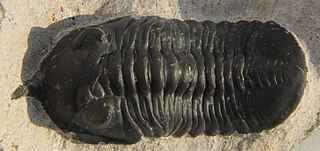
Morocconites malladoides is an average size trilobite, which lived during the Devonian period, in what is now southern Morocco. This species is assumed to be a close relative of Acastoides. The most conspicuous feature is the very long upcurved frontal medial spine, a bit like an avocet bill. It is the only known species in this genus.
Dianopachysaurus is an extinct genus of pachypleurosaur known from the lower Middle Triassic of Yunnan Province, southwestern China. It was found in the Middle Triassic Lagerstatte of the Guanling Formation. It was first named by Jun Liu, Olivier Rieppel, Da-Yong Jiang, Jonathan C. Aitchison, Ryosuke Motani, Qi-Yue Zhang, Chang-Yong Zhou and Yuan-Yuan Sun in 2011 and the type species is Dianopachysaurus dingi, thanking a Professor Ding for his help.

Alokistocaridae is a family of ptychopariid trilobites that lived from the Botomian epoch of the Early Cambrian until the Late Cambrian. Alokistocarids were particle feeders and left small furrows with are occasionally preserved. Their remains are found worldwide. Elrathia kingii, one of the most collected trilobites in the world, is a typical alokistocarid.

Rhynchonelloidella alemanica is a species of extinct, small-sized brachiopod, a marine rhynchonellate lampshell in the family Rhynchonellidae. It is roughly 9/16 inch (1.4 cm), and has about 15 ribs fanning out from the hinge.

Ptychoparia is a genus of ptychopariid trilobites, and is the type genus of the family Ptychopariidae, and the order Ptychopariida.

Conocoryphe is a genus of primarily eyeless trilobites belonging to the family Conocoryphidae. They lived during the Middle Cambrian period, about 505 million years ago. These arthropods lived on the sea bottom (epifaunal) and lived off dead particulate organic matter.
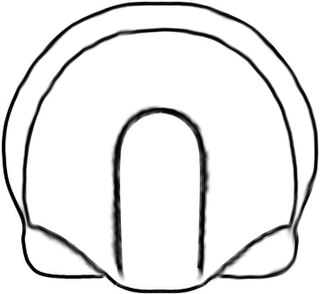
Mallagnostus is an extinct genus from a well-known class of fossil marine arthropods, the trilobites. It lived during the upper Lower Cambrian, with remains found in USA, Canada (Newfoundland), Spain, England, Russia, Mongolia, and the lower Middle Cambrian according to fossils from China and Russia (Yakutia).
Tannudiscus is an extinct genus from a well-known class of fossil marine arthropods, the trilobites. It lived during the upper Lower Cambrian, with remains found in Canada (Newfoundland), China (Gansu), The United Kingdom (England), and the Russian Federation.

Jinghediscus is an extinct genus from a well-known class of fossil marine arthropods, the trilobites. It lived during the lower Middle Cambrian, with remains found in China (Xinjiang) and Australia (Queensland).
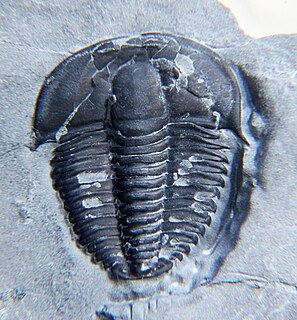
Kendallina is a genus of trilobite with an inverted egg-shaped outline, a wide headshield, small eyes, small deflected spines, 12 thorax segments and a small, short tailshield. It lived during the Upper Cambrian in what are today Canada and the United States.
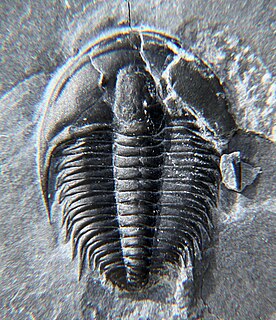
Orygmaspis is a genus of asaphid trilobite with an inverted egg-shaped outline, a wide headshield, small eyes, long genal spines, 12 spined thorax segments and a small, short tailshield, with four pairs of spines. It lived during the Upper Cambrian in what are today Canada and the United States.

Viaphacops is a genus of trilobites in the order Phacopida, family Phacopidae, that lived during the Middle Devonian, and is known from North and South America, Asia.
| This Phacopida-related article is a stub. You can help Wikipedia by expanding it. |